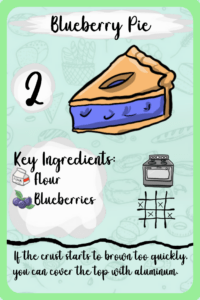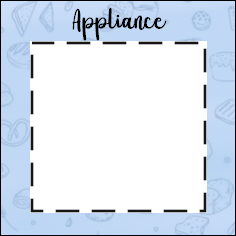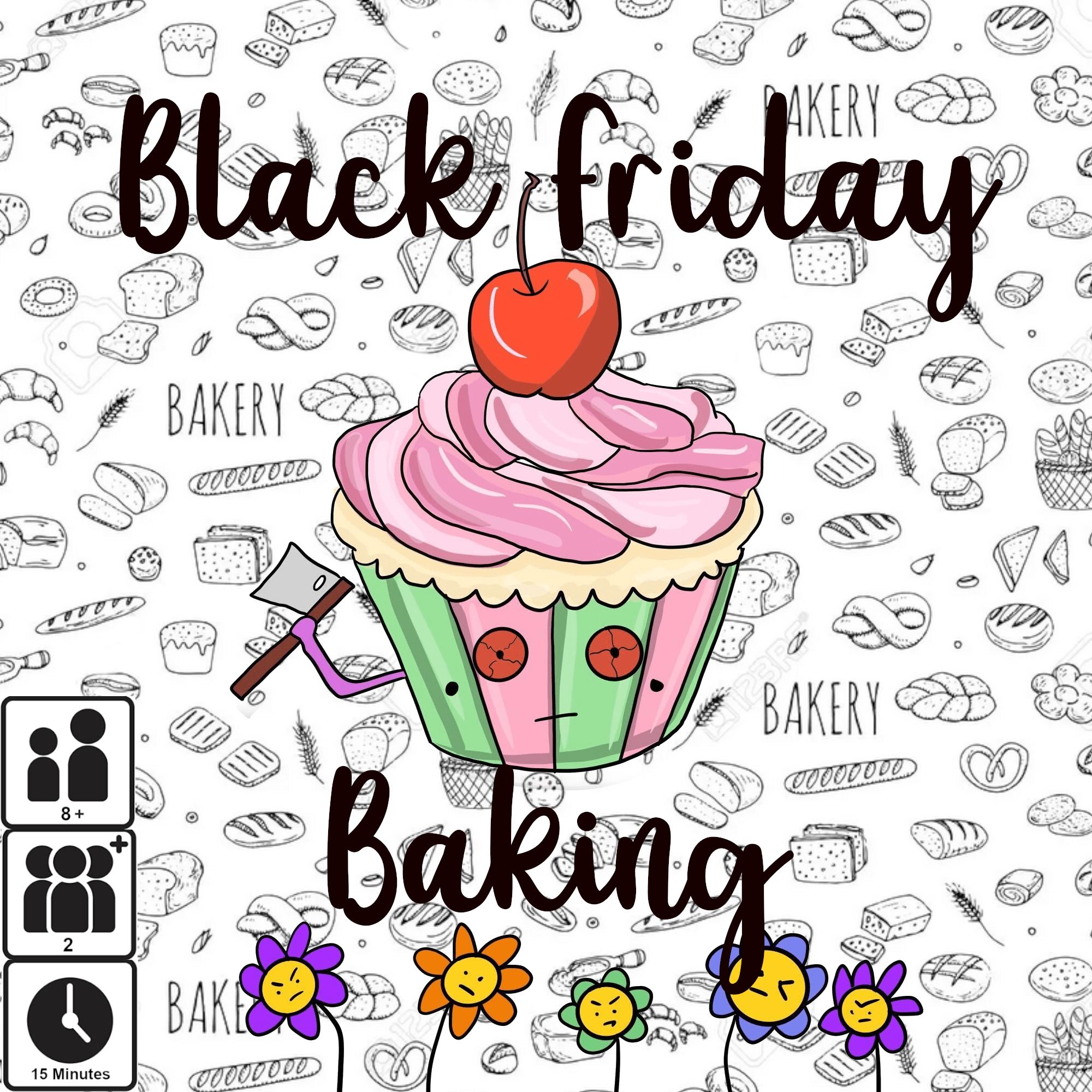Printable Version: https://drive.google.com/file/d/13tVBjquxmG6bAW9FzVjiz8Sho4EeFwnw/view?usp=sharing
Refinement Goals:
We had two main goals for Black Friday Baking for the goals of P4: refine the game’s packaging and design, as well as improving the game’s playability. For the former goal, we knew from the beginning that we wanted to make the transition to digital art. We also sought feedback from testers on the quality of both the aesthetics and information design of the game. For the second goal, we knew that the best way to gather data on how to improve was through extensive playtesting.
Updated Concept Statement:
Although a deceptively straightforward pastime, baking can be very intimidating for people just starting out. Whether the friction comes from having to purchase what seems like a million different ingredients for a “simple” dessert, or not having the fancy tools or bakeware, or online recipes being pages and pages of scrolling to reach the actual instructions, there are so many factors that contribute to this sense of intimidation or hesitance to start. To address this hurdle, we designed a 2-player competitive game that would teach players recipes and facts about baking. The recipes included in the game are relatively comprehensive so an inspired player might apply the recipes from the game to create delicious goods for their friends. We tried to include a vast variety of desserts to appeal to a broader audience, and to even teach people about new and interesting foods they may not have tried before. The recipe cards are digestible enough to hopefully lower the friction of approaching a new bake, and we tried to make the art as engaging and as welcoming as possible to foster excitement and enthusiasm and appeal. We purposely included more obscure bakes and recipes that require interesting and surprising twists. For an example of the former, we included marzipan and mango sticky rice—two deserts from different cultures that certain people are likely to not have run into (myself included). And for an interesting twist about a recipe that I learned while doing research for this project—I didn’t know that espresso is often included in chocolate cake in order to bring out the decadent flavor of the chocolate. We hope to test the teaching potential of our game by polling players after playtesting in class.
Our game is a strategic competitive game where players vie for resources on a 6×6 board where each tile represents an ingredient. They will have to plan ahead to place their chips wisely in order to build recipes faster than their opponent, while also paying close attention to the enemy’s moves. Additionally, there is the added complexity of having to acquire the appliances necessary to bake/cook each dessert as well. Chips that are used to build appliances can be reused for ingredients, but ingredients cannot be reused once they’ve been used. Without having an appliance, you cannot make a dessert, and the types of appliances differ per recipe and there will be a limited number of recipes at play at a single time. This also introduces a layer of challenge and strategy where players can balance blocking their opponent from obtaining both appliances and ingredients, while trying to obtain their own as well. Because of the strategic thinking required, we think the game will include the Challenge kind of fun. Furthermore, in previous playtests we noticed that despite competing against each other, players engaged in banter and talking about the thematic elements of the game. This is something we aim to foster throughout the “letters” in the rulebook and the associated box art. The game seemed to bring the two competing players closer together, therefore we believe it contains the Fellowship type of fun.
At the end of the game this is a strategic game where players compete for control of the board—there are many games of varying complexity that exist in this vein. A simple example is Tiny Towns where players control a small board by building a village. A significantly more complex example is Civilization, where players build, scout, trade, and even go to war to become the most powerful civilization in the game world.
Our biggest concern when developing this game was/is balancing it in such a way so that it is competitive, fun, and fair. The main things we’d need to get right in order to achieve this are the amount and size of recipes, the amount of ingredients, and the size of the board. This is a surprisingly difficult task as, despite the simple rules of the game, there are several areas of complexity in the size of the recipes, the boards, the amount of ingredients, the overlap of ingredients between recipes, and metagame tactics like blocking—since each one of these areas affects the others, changing one can have cascading consequences on the whole game. This is also introduced by the appliance meta as well, where the pace of the game can totally change when new recipes are added that require different kinds of appliances, so the game never truly has a predictable ending state and it is possible for players to make comebacks at any time due to the rotating lineup. This keeps the game fun and engaging throughout, and players must be involved until the last chip is placed.
History:
Version 0: This is the version we ended with for P1. Everything was hand-drawn, and while that aesthetic does come with its own atmospheric advantage, we decided to switch to digital art for a look that was more clean, consistent, and easy to parse.
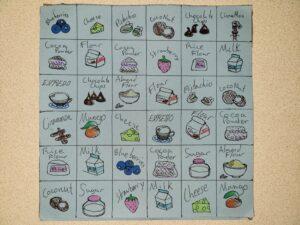

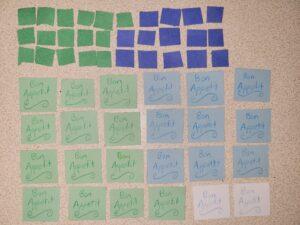
Version 1: This was the first version of the game with complete digital art. We also added a lot of elements that we’d meant to do during P1, but had run out of time to complete.
- Recipe Cards – The biggest thing we added to the cards was photos of desserts. Not only was this important for the look of the cards, but it also made it easier for players to tell what recipes they had at a glance.
- Appliance Cards – The most important update here was writing the name of the appliance on all four sides of the card, not just one. This helped indicate to the player that you can rotate the appliance shape.
- Appliance Markers – We made separate appliance markers, instead of having the player indicate appliances with the back of the Bon Appetit marker.
- Ingredient Markers – We added the letter “I” to the ingredient marker to indicate its function.
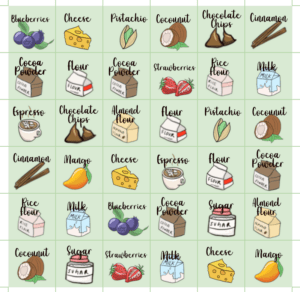
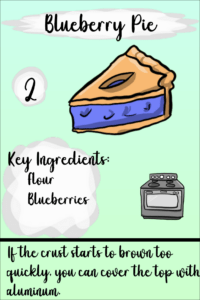
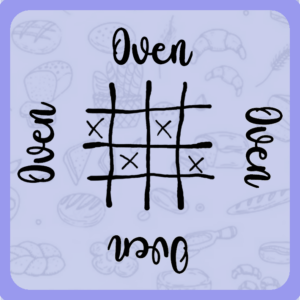
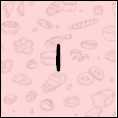
Version 2: For this version, we made some important changes to improve information design (thanks Gilbert for the feedback), in addition to some small aesthetic improvements.
- Recipe Cards – We made the point value of the card much bigger, to indicate its importance. We also added the iconography of the ingredients on the ingredient list, in addition to adding the shape of the appliances near the appliance indicator.
- Appliance Cards – We added the appliance iconography to the card.

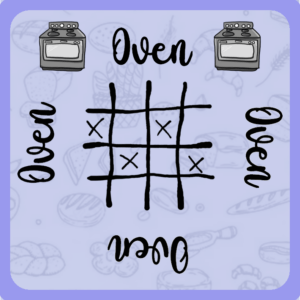
Version 3: Based on player feedback, we made general aesthetic adjustments to all the cards, including adding a background with faded baking-related images to everything. We also made the following playability improvements.
- Ingredient Markers: We added a picture of baking ingredients to the ingredient marker, instead of having the letter I. Testers thought it would be a lot more clear and eye-catching. Additionally, the “I” in our game font didn’t stand out enough.
- Appliance Marker – Testers suggested that the appliance markers have a transparent center, as the current markers covered up ingredients, leading them to forget they were there. To indicate this in the printable version, we had dotted lines to tell the player to cut out the center.
